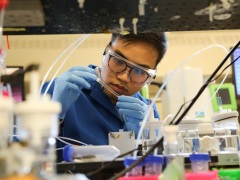Features
Reduced to clear
Date: 2019-04-30 09:16:38.0
Author: Jon Evans

Phil De Luna at the University of Toronto is the
lead author of a new paper in Science on the
electrocatalytic reduction of carbon dioxide.
Photo: Tyler Irving, U of T Engineering.
In one new study, scientists conclude that the electrocatalytic reduction of carbon dioxide could compete with fossil fuels for the production of important chemicals such as ethanol and ethylene if the electrical-to-chemical conversion efficiency can reach 60%. In another new study, scientists report that biofuels could help to achieve that level of efficiency.
The obvious advantage of producing industrial chemicals from the electrocatalytic reduction of carbon dioxide is that it would generate far less carbon dioxide than producing them from fossil fuels. If the electricity for powering the process is derived from renewable sources of energy, such as solar or wind, then it could even be carbon-negative. The disadvantage is that this process has to compete with a mature petrochemical industry that can currently produce these chemicals at large scales much more cheaply.
Electrocatalytic systems for reducing carbon dioxide have developed and improved over the past few years, such that the best ones can now reach electrical-to-chemical conversion efficiencies of 35–50%. These systems tend to be based on flow cells, in which carbon dioxide and an electrolyte solution flow through a cell separated into several chambers by an anion-exchange membrane and two gas diffusion electrodes.
Powered by electricity, the carbon dioxide is catalytically reduced in the cathode chamber and the water in the electrolyte solution is split by other catalysts into oxygen and hydrogen in the anode chamber. The reduced carbon dioxide and hydrogen then migrate into a central chamber, where they react together to form hydrocarbons.
A team of scientists from Canada and the US, led by Edward Sargent at the University of Toronto, wanted to know how efficient this process would need to be to produce base chemicals such as ethanol and ethylene as cheaply as the petrochemical industry. As reported in a paper in Science, by conducting a simple life-cycle analysis they discovered that the conversion process would need to reach an efficiency 60% at an electricity price of 4 cents per kilowatt-hour to start being competitive with petrochemicals.
This electricity price is already close to the wholesale price. In addition, over the past few years, the cost of renewable energy has steadily fallen, and certain facilities can also generate electricity at close to, or even slightly below, that price.
So the trick now is to develop processes that can not only achieve the 60% efficiency, but can do so at large scales. “For ethylene, the best I've seen is about 35% efficiency, but for some other building blocks, such as carbon monoxide, we're approaching 50%,” says team member Phil De Luna at the University of Toronto. “Of course, all this has been done in labs – it's a lot harder to scale that up to a plant that can make kilotonnes per day.”
One potential way to get closer to this level of efficiency was recently reported in a paper in Nature Energy by Paul Kenis and his colleagues at the University of Illinois at Urbana-Champaign, US. It’s based on a flow cell that Kenis developed in 2015 for converting carbon dioxide into ethanol and ethylene, which employed two different electrolytes in the anode and cathode chambers. The problem with this flow cell, as with all others, is that the water splitting reaction requires a lot of energy, accounting for 90% of the electricity consumed by the flow cell.
But Kenis and his colleagues have now managed to reduce this energy consumption by up to 53% by simply adding glycerol, a waste product from biodiesel production, to the electrolyte in the anode chamber. This allows hydrogen to be produced from the electrocatalytic breakdown of glycerol, which requires less electricity than splitting water. What is more, other organic materials might work just as well.
"The glycerol-based electrolysis reaction shows a lot of promise,” says Kenis “However, we will continue to explore other organic waste materials because even when production rises in the wake of increased biofuel production, it still will not be enough to fully support the need."
The views represented here are solely those of the author and do not necessarily represent those of John Wiley and Sons, Ltd. or of the SCI.
Displaying 2 keywords used to tag this article:
- Jules Audemars-Australia Best Quali
- DG6582 Mens Moncler Down Jackets Gr
